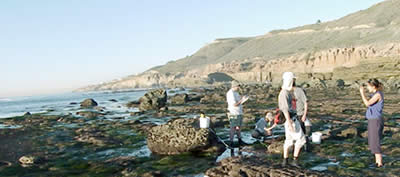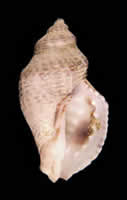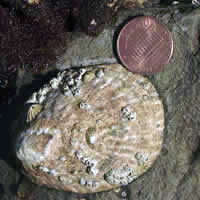UCSD Biologists' Study Links Human Impacts Along The Coast To Size Declines Of Marine Snails In Southern California
February 28, 2003
By: Kim McDonald
The average size of marine snails and limpets along the Southern California coast has declined significantly over the past century and collection by humans appears to be the culprit, according to a study led by biologists at the University of California, San Diego.

Their study, published in the March issue of the journal Ecology Letters, sheds light on an ecological problem linked to human population growth on the coast that has received little attention from conservationists and, yet, has important implications for the enforcement of conservation laws in coastal habitats.

K. Roy, UCSD
"We show that since 1869, human exploitation has led to a striking decrease in the sizes of many marine invertebrate species," says Kaustuv Roy, an associate professor of biology at UCSD and the first author of the study. "The effects are pervasive and not restricted to species that are commonly exploited for food. We also show in the study that these effects can be mitigated if current laws are enforced, but that such enforcement is largely lacking in the Southern California region."
Roy conducted the study with biologists Allen Collins of UCSD's Division of Biological Sciences, Bonnie Becker of UCSD's Scripps Institution of Oceanography and the U.S. National Park Service, Emina Begovic of UC Berkeley and John Engle of UC Santa Barbara's Marine Science Institute. They compared museum collections of shells dating back to 1869 with field samples of four species of gastropods along 120 miles of the Southern California coastline. The species chosen varied in their body sizes, life habits and tendency to be harvested by humans.

A. G. Collins, UCSD
Of the four species, the owl limpet, Lottia gigantea is the only one known to be extensively collected as a food item. The Gilded turban snail, Tegula aureotincta is occasionally harvested, but the last two species studied, the volcano keyhole limpet, Fissurella volcano and Acanthinucella spirata, a small predatory snail, are not known to be exploited for food.
When humans gather intertidal species, they preferentially collect larger individuals. This reduces the average body size of remaining populations by leaving only smaller individuals to reproduce and pass their genes to the next generation. The researchers hypothesized that if harvesting were the only factor acting on the populations, size declines would be observed in owl limpets and to a lesser extent Gilded turban snails, but not the other two species.
However, size declines were found in all four species. From the specimens in the museums collected during the 1800s to the living gastropods, which were collected and measured at 14 separate field sites along the coast, the researchers showed that the average body sizes of all four gastropods declined significantly over time.
"The declines in the non-harvested species were a surprise," notes Roy. "Nobody expected it."
While Southern California's human population doubled over the last four decades, the researchers weren't certain this was the source of the declines. Environmental factors, such as climate change, for example, could have played a role.
To test the hypothesis that humans are indeed responsible, the researchers examined the size distributions of the four species of gastropods along the coast at the Cabrillo National Monument in Point Loma, just outside San Diego Bay. This is the only intertidal reserve in Southern California with zones where humans are prohibited and where collecting laws have been strictly enforced over the last few decades. At this reserve, the average lengths of all four species were significantly greater than at the other field sites, and the researchers needed less time to find large individuals.
For two of the species, specimens found at Point Loma were actually larger than museum specimens. These data strongly suggest that human activity, not environmental change, has led to the diminished size of gastropods on the southern California coast, the researchers conclude in their paper.
"In California, we don't know how many intertidal species are being harvested and how," says Roy. "Besides the few that are known food items, many others are almost certainly being taken, but at present the California State Department of Fish and Game does not keep track of which species are being collected and where."
Body size reductions are of particular concern in certain species, such as owl limpets, which sequentially change their sex from male to female. This means that larger individuals tend to be female and the body size declines may inhibit reproduction in these populations. One of Roy's students is currently investigating whether or not there have been sex ratio changes in populations of owl limpets.
Previous studies have revealed other impacts that humans are having on marine environments, including size declines in some fish populations. "The size declines in fish are perhaps easier to understand," explains Roy. "They are largely the result of overexploitation and the selective catch of certain sized fish. The intertidal situation is much more complex. I hope our study highlights the fact that human impact on the marine environment is not just restricted to fisheries, or coral reefs, where most of the attention is now being focused."
Financial support for the study was provided by the University of California Marine Council's Coastal Environmental Quality Initiative, The San Diego Foundation, Cabrillo National Monument Foundation, U.S. National Park Service and the U.S. Navy.
